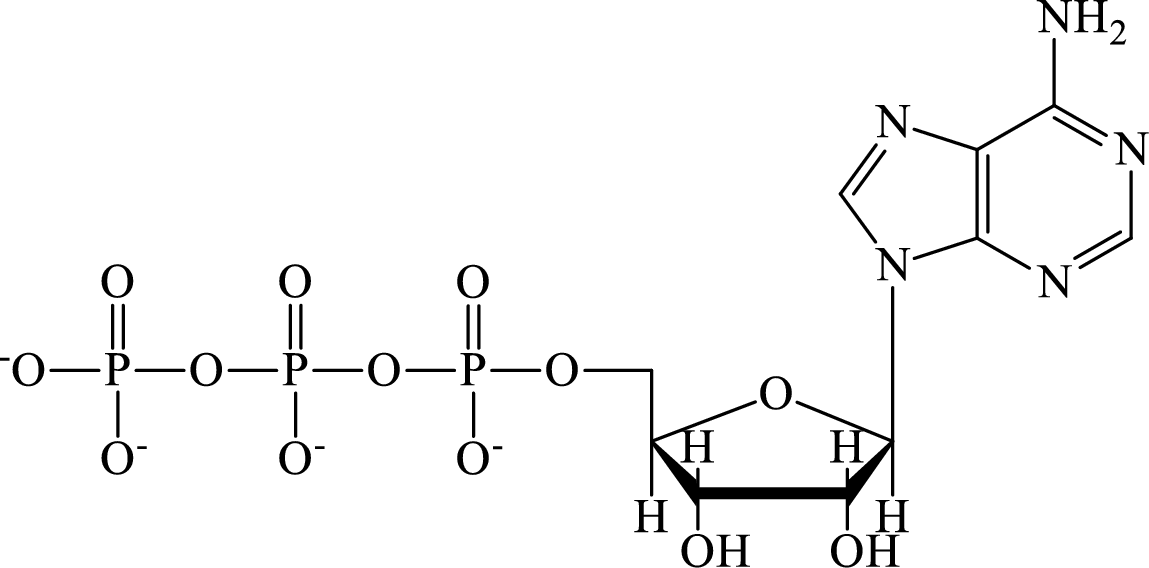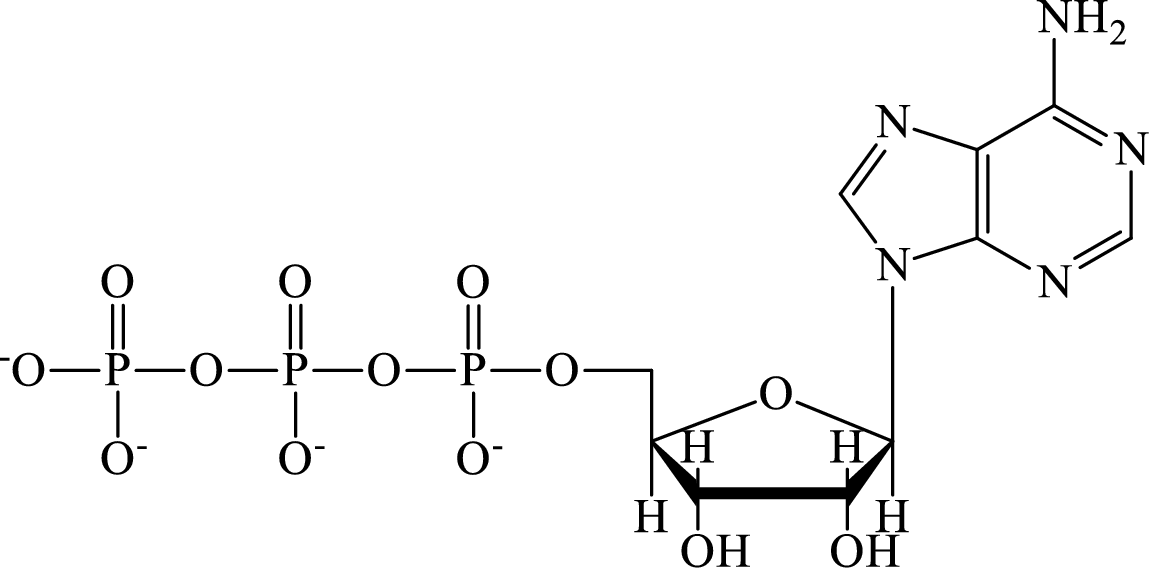
EBK GENERAL, ORGANIC, AND BIOLOGICAL CH
7th Edition
ISBN: 9780100853188
Author: STOKER
Publisher: YUZU
expand_more
expand_more
format_list_bulleted
Concept explainers
Question
Chapter 23, Problem 23.116EP
(a)
Interpretation Introduction
Interpretation: To determine the reactants in oxidative phosphorylation.
Concept introduction: Oxidative phosphorylation is the biochemical process for the synthesis of ATP from ADP and
The structure of ATP is:

(b)
Interpretation Introduction
Interpretation: To determine the products in oxidative phosphorylation.
Concept introduction: Oxidative phosphorylation is the biochemical process for the synthesis of ATP from ADP and
The structure of ATP is:

Expert Solution & Answer
Want to see the full answer?
Check out a sample textbook solution
Students have asked these similar questions
Please EnCircle or Fill-In your Choice CLEARLY:
21. Please Sketch the intermediates for each step below.
Draw the Product which would result from the following series of reactions.
Name each Type of Rx:
1. Br2, FeBr3
2. Mg, ether
3. ethylene oxide
4. H₂O+
5. PBr3
6. Mg, ether
7.
8. H3O+, heat (-H₂O
9. HF
?
Can I please get help with this question. All required information should be in data table.
esc
For the reaction below:
1. Draw all reasonable elimination products to the right of the arrow.
2. In the box below the reaction, redraw any product you expect to be a major product.
Major Product:
Explanation
Check
C
☐
+
X
NaOH
Br
F1
F2
80
F3
F4
F5
F6
1
!
@
2
3
$
4
%
5
Q
W
LU
E
S
D
A
F7
*
C
Click and dr
drawing a
2025 McGraw Hill LLC. All Rights Reserv
►II
F8
4
F9
6
7
8
9
R
T
Y
U
LL
F
G
H
J
Chapter 23 Solutions
EBK GENERAL, ORGANIC, AND BIOLOGICAL CH
Ch. 23.1 - Prob. 1QQCh. 23.1 - Prob. 2QQCh. 23.2 - Which of the following is not found within the...Ch. 23.2 - Which of the following is not an organelle? a....Ch. 23.2 - Prob. 3QQCh. 23.2 - Prob. 4QQCh. 23.3 - Which of the following statements concerning...Ch. 23.3 - Prob. 2QQCh. 23.3 - Which of the following statements concerning...Ch. 23.3 - Which of the following statements concerning...
Ch. 23.3 - Which of the following statements concerning...Ch. 23.4 - Prob. 1QQCh. 23.4 - Prob. 2QQCh. 23.5 - Prob. 1QQCh. 23.5 - Prob. 2QQCh. 23.5 - Prob. 3QQCh. 23.6 - Which of the following occurs in the second stage...Ch. 23.6 - Which of the following stages in the biochemical...Ch. 23.6 - Prob. 3QQCh. 23.7 - Prob. 1QQCh. 23.7 - Prob. 2QQCh. 23.7 - Prob. 3QQCh. 23.7 - How many NADH and FADH2 molecules are produced,...Ch. 23.7 - Which of the following citric acid cycle...Ch. 23.7 - In which of the following listings of citric acid...Ch. 23.8 - Which of the following is a fuel for the electron...Ch. 23.8 - Prob. 2QQCh. 23.8 - What is the substrate that initially interacts...Ch. 23.8 - The number of fixed enzyme sites in the electron...Ch. 23.8 - In which of the following listings of electron...Ch. 23.8 - Prob. 6QQCh. 23.9 - How many of the four enzyme complexes in the...Ch. 23.9 - Prob. 2QQCh. 23.9 - Prob. 3QQCh. 23.10 - Prob. 1QQCh. 23.10 - Prob. 2QQCh. 23.11 - Prob. 1QQCh. 23.11 - Prob. 2QQCh. 23.11 - Prob. 3QQCh. 23.12 - Prob. 1QQCh. 23.12 - Prob. 2QQCh. 23 - Classify anabolism and catabolism as synthetic or...Ch. 23 - Classify anabolism and catabolism as...Ch. 23 - What is a metabolic pathway?Ch. 23 - Prob. 23.4EPCh. 23 - Classify each of the following processes as...Ch. 23 - Classify each of the following processes as...Ch. 23 - Prob. 23.7EPCh. 23 - Prob. 23.8EPCh. 23 - Prob. 23.9EPCh. 23 - Indicate whether each of the following statements...Ch. 23 - Prob. 23.11EPCh. 23 - Prob. 23.12EPCh. 23 - Prob. 23.13EPCh. 23 - Prob. 23.14EPCh. 23 - Specify, by name and by number present, the...Ch. 23 - Prob. 23.16EPCh. 23 - Prob. 23.17EPCh. 23 - Prob. 23.18EPCh. 23 - Prob. 23.19EPCh. 23 - Prob. 23.20EPCh. 23 - Prob. 23.21EPCh. 23 - Prob. 23.22EPCh. 23 - Write a generalized chemical equation, containing...Ch. 23 - Prob. 23.24EPCh. 23 - Prob. 23.25EPCh. 23 - Prob. 23.26EPCh. 23 - Draw each of the following types of block diagrams...Ch. 23 - Prob. 23.28EPCh. 23 - What is the name of the B vitamin present in each...Ch. 23 - Prob. 23.30EPCh. 23 - Prob. 23.31EPCh. 23 - Prob. 23.32EPCh. 23 - Prob. 23.33EPCh. 23 - Prob. 23.34EPCh. 23 - Prob. 23.35EPCh. 23 - Prob. 23.36EPCh. 23 - Prob. 23.37EPCh. 23 - Prob. 23.38EPCh. 23 - Prob. 23.39EPCh. 23 - Prob. 23.40EPCh. 23 - Prob. 23.41EPCh. 23 - Prob. 23.42EPCh. 23 - Prob. 23.43EPCh. 23 - Prob. 23.44EPCh. 23 - Prob. 23.45EPCh. 23 - Prob. 23.46EPCh. 23 - Prob. 23.47EPCh. 23 - Prob. 23.48EPCh. 23 - Prob. 23.49EPCh. 23 - Prob. 23.50EPCh. 23 - Prob. 23.51EPCh. 23 - Prob. 23.52EPCh. 23 - Prob. 23.53EPCh. 23 - Prob. 23.54EPCh. 23 - Prob. 23.55EPCh. 23 - Prob. 23.56EPCh. 23 - Prob. 23.57EPCh. 23 - Prob. 23.58EPCh. 23 - List, by name, the four general stages of the...Ch. 23 - Prob. 23.60EPCh. 23 - Prob. 23.61EPCh. 23 - Prob. 23.62EPCh. 23 - Prob. 23.63EPCh. 23 - Prob. 23.64EPCh. 23 - Prob. 23.65EPCh. 23 - Prob. 23.66EPCh. 23 - Prob. 23.67EPCh. 23 - Prob. 23.68EPCh. 23 - Prob. 23.69EPCh. 23 - Prob. 23.70EPCh. 23 - Prob. 23.71EPCh. 23 - Prob. 23.72EPCh. 23 - Prob. 23.73EPCh. 23 - Prob. 23.74EPCh. 23 - Prob. 23.75EPCh. 23 - Prob. 23.76EPCh. 23 - Prob. 23.77EPCh. 23 - Prob. 23.78EPCh. 23 - Prob. 23.79EPCh. 23 - Prob. 23.80EPCh. 23 - Prob. 23.81EPCh. 23 - Prob. 23.82EPCh. 23 - Prob. 23.83EPCh. 23 - Prob. 23.84EPCh. 23 - Prob. 23.85EPCh. 23 - Prob. 23.86EPCh. 23 - Prob. 23.87EPCh. 23 - Prob. 23.88EPCh. 23 - Indicate whether each of the following changes...Ch. 23 - Prob. 23.90EPCh. 23 - Prob. 23.91EPCh. 23 - Prob. 23.92EPCh. 23 - Which electron carrier shuttles electrons between...Ch. 23 - Prob. 23.94EPCh. 23 - Prob. 23.95EPCh. 23 - Prob. 23.96EPCh. 23 - Prob. 23.97EPCh. 23 - Prob. 23.98EPCh. 23 - Prob. 23.99EPCh. 23 - Prob. 23.100EPCh. 23 - Put the following substances in the correct order...Ch. 23 - Prob. 23.102EPCh. 23 - Prob. 23.103EPCh. 23 - Prob. 23.104EPCh. 23 - Prob. 23.105EPCh. 23 - Prob. 23.106EPCh. 23 - Prob. 23.107EPCh. 23 - Prob. 23.108EPCh. 23 - Prob. 23.109EPCh. 23 - Prob. 23.110EPCh. 23 - How many protons cross the inner mitochondrial...Ch. 23 - How many protons cross the inner mitochondrial...Ch. 23 - Prob. 23.113EPCh. 23 - Prob. 23.114EPCh. 23 - Prob. 23.115EPCh. 23 - Prob. 23.116EPCh. 23 - Prob. 23.117EPCh. 23 - Prob. 23.118EPCh. 23 - Prob. 23.119EPCh. 23 - Prob. 23.120EPCh. 23 - Prob. 23.121EPCh. 23 - Prob. 23.122EPCh. 23 - Prob. 23.123EPCh. 23 - Prob. 23.124EPCh. 23 - Prob. 23.125EPCh. 23 - Prob. 23.126EPCh. 23 - Prob. 23.127EPCh. 23 - Prob. 23.128EPCh. 23 - Indicate whether or not each of the following B...Ch. 23 - Prob. 23.130EPCh. 23 - Prob. 23.131EPCh. 23 - Prob. 23.132EP
Knowledge Booster
Learn more about
Need a deep-dive on the concept behind this application? Look no further. Learn more about this topic, biology and related others by exploring similar questions and additional content below.Similar questions
- Calculate equilibrium concentrations for the following reaction:N2 (g) + O2 (g) ⇋ 2 NO (g) Kc = 0.10 at 2273K initially [N2] = 0.200M; [O2] = 0.200arrow_forwardFor each scenario below, select the color of the solution using the indicator thymol blue during the titration. When you first add indicator to your Na2CO3solution, the solution is basic (pH ~10), and the color is ["", "", "", "", ""] . At the equivalence point for the titration, the moles of added HCl are equal to the moles of Na2CO3. One drop (or less!) past this is called the endpoint. The added HCl begins to titrate the thymol blue indicator itself. At the endpoint, the indicator color is ["", "", "", "", ""] . When you weren't paying attention and added too much HCl (~12 mL extra), the color is ["", "", "", "", ""] . When you really weren't paying attention and reached the second equivalence point of Na2CO3, the color isarrow_forwardThe following reaction is run in which the initial conditions include only methane (CH4) at a concentration of0.115 M. Once equilibrium was established, the concentration of acetylene (C2H2) was measured to be 0.035M. What is the value of the equilibrium constant, K?2 CH4 (g) ⇋ C2H2 (g) + 3 H2 (g)arrow_forward
- Calculate the equilibrium concentration of carbon dioxide for the following reaction:2 COF2 (g) ⇋ CF4 (g) + CO2 (g) Kc = 2.00 at 10.00 °C. at equilibrium [COF2] = 0.255M; [CF4] = 0.118Marrow_forwardIn a benzene derivative that has -CH2CH3, indicate how it can be substituted by -COOH.arrow_forwardIn a sulfonated derivative of benzene, indicate how -SO3H can be eliminated.arrow_forward
- What is the equilibrium expression (law of mass action) for the following reaction:CO2 (g) + H2O (l) ⇋ H+ (aq) + HCO3- (aq)arrow_forwardIndicate the compound resulting from adding NaOH cyclopentane-CH2-CHO.arrow_forwardUse the provided information to calculate Kc for the following reaction at 550 °C: H2(g) + CO2(g) ⇌ CO(g) + H2O(g) Kc = ?CoO(s) + CO(g) ⇌ Co(s) + CO2(g) Kc1 = 490CoO(s) + H2(g) ⇌ Co(s) + H2O(g) Kc2 = 67arrow_forward
- Calculate Kc for the reaction: I2 (g) ⇋ 2 I (g) Kp = 6.26 x 10-22 at 298Karrow_forwardFor each scenario below, select the color of the solution using the indicator thymol blue during the titration. When you first add indicator to your Na2CO3solution, the solution is basic (pH ~10), and the color is ["", "", "", "", ""] . At the equivalence point for the titration, the moles of added HCl are equal to the moles of Na2CO3. One drop (or less!) past this is called the endpoint. The added HCl begins to titrate the thymol blue indicator itself. At the endpoint, the indicator color is ["", "", "", "", ""] . When you weren't paying attention and added too much HCl (~12 mL extra), the color is ["", "", "", "", ""] . When you really weren't paying attention and reached the second equivalence point of Na2CO3, the color isarrow_forwardTo convert cyclopentane-CH2-CHO to cyclopentane-CH2-CH3, compound A is added, followed by (CH3)3CO-K+, DMS at 100oC. Indicate which compound A is.arrow_forward
arrow_back_ios
SEE MORE QUESTIONS
arrow_forward_ios
Recommended textbooks for you
 General, Organic, and Biological ChemistryChemistryISBN:9781285853918Author:H. Stephen StokerPublisher:Cengage Learning
General, Organic, and Biological ChemistryChemistryISBN:9781285853918Author:H. Stephen StokerPublisher:Cengage Learning Organic And Biological ChemistryChemistryISBN:9781305081079Author:STOKER, H. Stephen (howard Stephen)Publisher:Cengage Learning,
Organic And Biological ChemistryChemistryISBN:9781305081079Author:STOKER, H. Stephen (howard Stephen)Publisher:Cengage Learning, Chemistry for Today: General, Organic, and Bioche...ChemistryISBN:9781305960060Author:Spencer L. Seager, Michael R. Slabaugh, Maren S. HansenPublisher:Cengage Learning
Chemistry for Today: General, Organic, and Bioche...ChemistryISBN:9781305960060Author:Spencer L. Seager, Michael R. Slabaugh, Maren S. HansenPublisher:Cengage Learning

General, Organic, and Biological Chemistry
Chemistry
ISBN:9781285853918
Author:H. Stephen Stoker
Publisher:Cengage Learning

Organic And Biological Chemistry
Chemistry
ISBN:9781305081079
Author:STOKER, H. Stephen (howard Stephen)
Publisher:Cengage Learning,

Chemistry for Today: General, Organic, and Bioche...
Chemistry
ISBN:9781305960060
Author:Spencer L. Seager, Michael R. Slabaugh, Maren S. Hansen
Publisher:Cengage Learning
